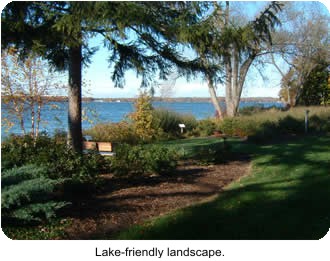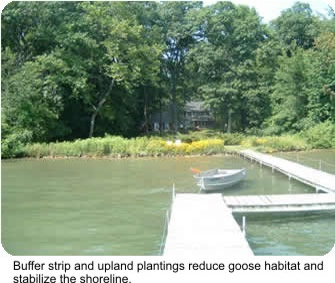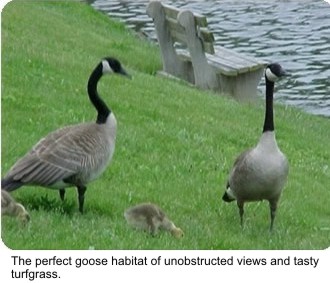Property Owners
Congratulations on being a Michigan lakefront property owner! Living “on the edge” offers a lifestyle that is framed by shoreline – that ecologically sensitive transition between land and water. Shoreline property owners interested in protecting or improving the health of their lake may have questions about managing their shoreline with respect to the lake’s littoral zone. Lakescaping, or alternative shoreline landscaping, strives to protect or restore shoreline areas to protect this zone that is so important to lake ecology.
Lakescaping involves the following principles:
Stormwater Retention
Trapping and infiltrating stormwater is a key component in protecting and improving lake water quality. Rainwater collecting on rooftops, walkways and parking lots tends to move overland to the lake, taking with it soil particles, lawn fertilizers and vehicle fluids. Development around lakes many times creates “pinch points” that collect and funnel stormwater into and through a property, causing soil erosion and washouts. KBS Lakescape One demonstrates a simple solution to overland flow of stormwater. Rain gardens are popular lakescape features that add beauty and retain stormwater. However, more technical solutions may be called for depending on the surface upon which stormwater is collected and the potential for pollutant delivery to groundwater.
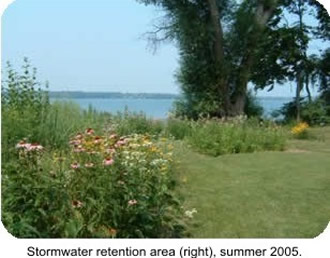
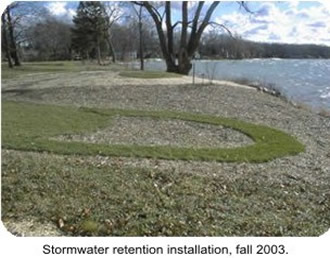
Habitat Enhancement
Wildlife viewing is one reason people enjoy living on lakes. Through publications like “Lakescaping for Wildlife and Water Quality” lakefront property owners are realizing that restoring native shoreline vegetation can enhance that experience.The Michigan Native Plant Producers Association and the Wildflower Association of Michigan are resources for education and supplies.
Shoreline Erosion Control
The proliferation of vertical sea walls around inland lakes is causing problems for lake ecosystems. They create an abrupt interruption of a natural transition from land to water. Wave energy is no longer absorbed by natural shoreline slope and vegetation, but is diverted downward and to neighboring properties. Whenever possible, vertical seawall should be avoided as an erosion control solution. However, if you already have a seawall there are ways to work with it in your restoration plan.
Many times shoreline erosion is made worse by a level control structure that places the lake surface at an unnaturally high level and in contact with soils less able to withstand the erosive forces of waves and ice.
Rock riprap that slopes into the lake provides protection against erosion but also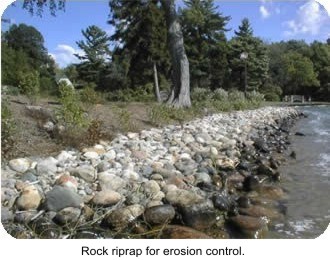 allows for movement of reptiles and amphibians from water to land. Spaces between the rocks also provide cover for fish and crustaceans. It is necessary to line riprap with geotextile fabric to prevent soil particles from being dislodged by wave energy. Interplanting, or joint planting, with woody shrubs can create a softer look, disperse wave energy and create more wildlife habitat at the water’s edge.
allows for movement of reptiles and amphibians from water to land. Spaces between the rocks also provide cover for fish and crustaceans. It is necessary to line riprap with geotextile fabric to prevent soil particles from being dislodged by wave energy. Interplanting, or joint planting, with woody shrubs can create a softer look, disperse wave energy and create more wildlife habitat at the water’s edge.
Vegetative solutions to control shoreline erosion can vary from a simple buffer strip of long-rooted native plants and shrubs to soil bioengineered structures similar to those used in the KBS Shoreline Management Demonstration Area. There are new products and techniques to vegetatively control shoreline erosion being developed to meet customer demand for more natural solutions.
Reduced Lawn Maintenance
Lakescaping strives to reduce the intensity of management in sensitive shoreline areas. Lakescapes that require less mowing, watering, fertilizer, insecticides and herbicides can reduce impact. For example, a buffer strip of long-rooted native plants can serve to reduce lawn maintenance, enhance songbird and butterfly habitat, trap stormwater and stabilize eroding soils. However, property owners should be prepared to manage weeds until the buffer strip is well established.
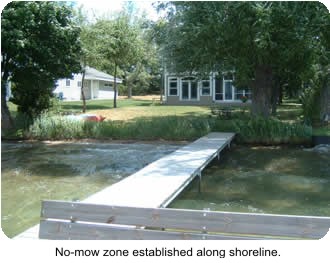 Many property owners establish a no-mow zone as a first step in lakescape planning. No-mow zones allow for experimentation with a taller “look” in a variety of depths, shapes and contours along the shoreline. They continue to mow their access areas (around beaches and docks) but strive to reduce these areas to less than 50 percent of their frontage. (The Michigan Department of Natural Resources recommends that 75 percent of a lake shoreline should remain undeveloped or restored to support a healthy fish population. MDNR Fisheries Division Special Report 38 – 1.42 MB pdf.)
Many property owners establish a no-mow zone as a first step in lakescape planning. No-mow zones allow for experimentation with a taller “look” in a variety of depths, shapes and contours along the shoreline. They continue to mow their access areas (around beaches and docks) but strive to reduce these areas to less than 50 percent of their frontage. (The Michigan Department of Natural Resources recommends that 75 percent of a lake shoreline should remain undeveloped or restored to support a healthy fish population. MDNR Fisheries Division Special Report 38 – 1.42 MB pdf.)
Some property owners are surprised to see what springs from old shoreline seed beds when they stop mowing. If a shoreline still has it’s natural grade (not filled), wetland wildflowers like swamp milkweed may grow.
Reduced turf areas also mean less Canada Goose habitat. These unwelcome visitors deposit messy, fertilizer-laden droppings and prefer shorelines with unobstructed views and tender turfgrass. A lakescape that incorporates a 36-inch high by 20-foot deep dense buffer strip, or no-mow zone, can discourage geese – especially if the access area is narrow and turf area behind the buffer is reduced with islands of native plants or shrubs.
